| Article ID | Journal | Published Year | Pages | File Type |
|---|---|---|---|---|
| 1695207 | Applied Clay Science | 2012 | 8 Pages |
A series of poly(oxypropylene)-amidoamine (POAA) compounds as potential shale inhibitors were synthesized by condensation of low molar mass polyoxypropylene diamine POP230 with diacids. The synthesized polymer was characterized by Fourier transform infrared spectroscopy (FT-IR) and mass spectrum (MS) analysis. The interaction between the POAA compounds and purified bentonite was investigated via FT-IR, X-ray diffraction (XRD), electrophoretic mobility (EM) measurement, thermogravimetric analysis (TGA), water adsorption test, and scanning electron microscopy (SEM). The POAA compounds were intercalated by the montmorillonite (Mt) with monolayer orientation. The protonated ammonium ions neutralized the negatively charged sites and decreased the electrophoretic mobility. Hydrogen bonds were formed between amide and siloxane groups. The intercalation reduced the water content of the Mt and rendered the clay mineral surface more hydrophobic. The inhibitive properties of the modified Mt were evaluated by inhibition and cuttings hot-rolling dispersion tests. The POAA-Mt exhibited superior shale hydration and dispersion inhibition capacity compared to conventional inhibitors.
► Poly(oxypropylene)-amidoamine as potential shale inhibitor. ► The polymers intercalated into the montmorillonite forming a monolayer arrangement. ► Poly(oxypropylene)-amidoamine was superior to conventional shale inhibitors.
